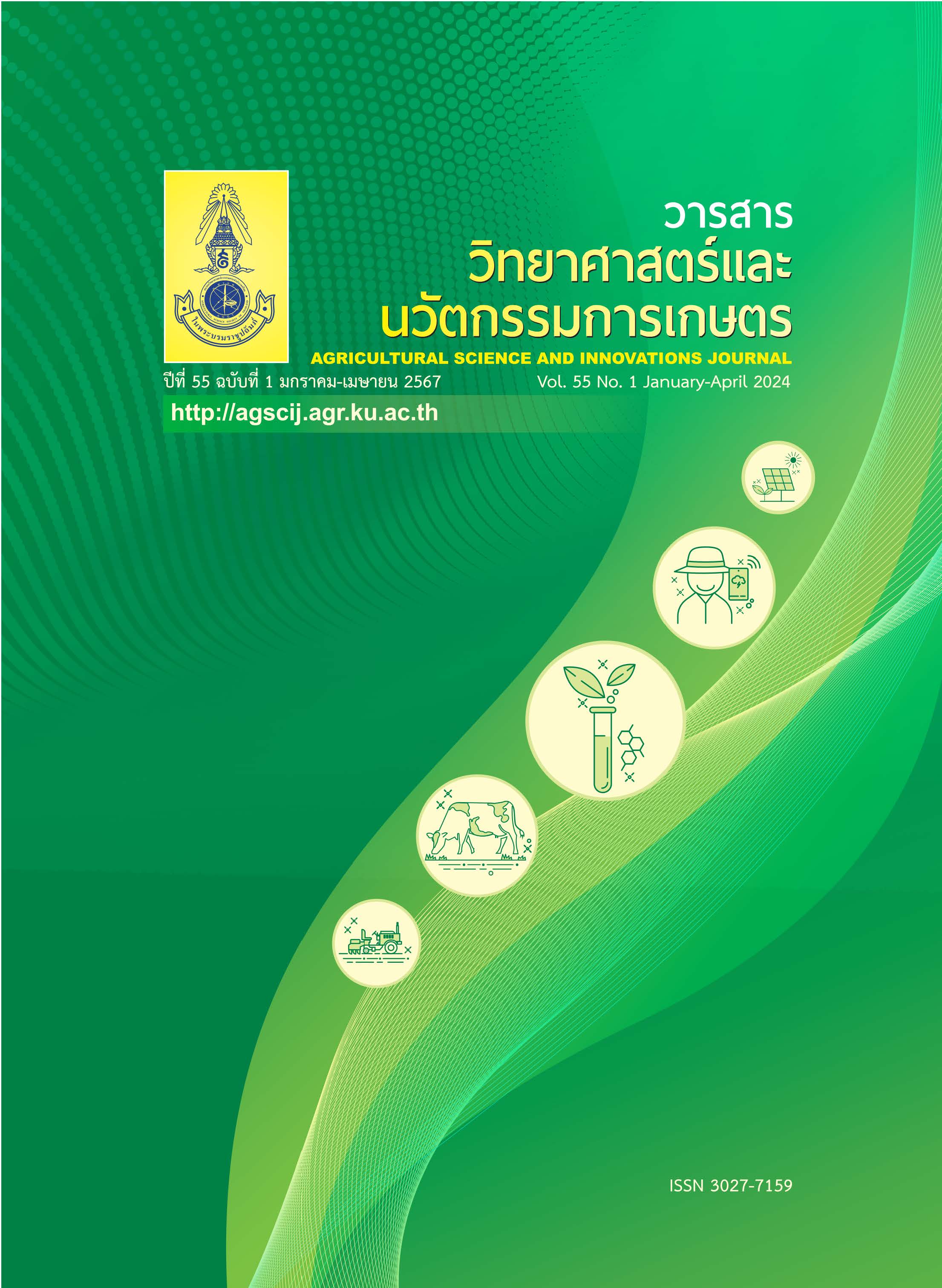ประสิทธิภาพสารสกัดหยาบแห้วหมู (Cyperus rotundus L.) ในการควบคุมหนอนกระทู้ข้าวโพดลายจุด (Spodoptera frugiperda (J.E. Smith)) ในสภาพห้องปฏิบัติการ
Main Article Content
บทคัดย่อ
ความเป็นมาและวัตถุประสงค์: หนอนกระทู้ข้าวโพดลายจุด (Spodoptera frugiperda (J.E. Smith)) เป็นแมลงอยู่ในวงศ์ Noctuidae ซึ่งเป็นแมลงศัตรูพืชที่สำคัญ เนื่องจากสามารถกินพืชอาหารได้หลากหลายชนิด จึงสร้างความเสียหายกับผลผลิตทางการเกษตรได้หลากหลาย ทั้งนี้ การใช้สารเคมีกำจัดแมลงในการควบคุมนิยมใช้เป็นวิธีหลักในการควบคุมหนอนชนิดนี้ ปัจจุบันพบปัญหาหนอนกระทู้ข้าวโพดลายจุดพัฒนาเพื่อต้านทานต่อสารกำจัดแมลงมากมาย งานวิจัยนี้มีวัตถุประสงค์เพื่อศึกษาประสิทธิภาพของสารสกัดหยาบจากหญ้าแห้วหมูและศึกษาผลกระทบต่อการพัฒนาในหนอนกระทู้ข้าวโพดลายจุดในห้องปฏิบัติการ
วิธีดำเนินการวิจัย: สารสกัดหยาบจากหญ้าแห้วหมูถูกสกัดด้วยตัวทำละลายเฮกเซน ไดคลอโรมีเทน เอธิลอะซิเตต และเมทานอล ตามลำดับ จากนั้น นำมาศึกษาความเป็นพิษและศึกษาผลกระทบต่อการเปลี่ยนแปลงรูปร่างของหนอนกระทู้ข้าวโพดลายจุดวัย 2 ในห้องปฏิบัติการเมื่อรับสารโดยวิธีสัมผัสจากด้านบน
ผลการวิจัย: สารสกัดหยาบจากไดคลอโรมีเทนมีฤทธิ์การออกฤทธิ์ในการกำจัดหนอนกระทู้ข้าวโพดลายจุดดีที่สุด โดยมีค่า LD50 เท่ากับ 4.58 ไมโครกรัมต่อตัว และส่งผลต่อการเปลี่ยนแปลงรูปร่างของหนอนกระทู้ข้าวโพดลายจุดมากที่สุด โดยสามารถทำให้เกิดความผิดปกติของการพัฒนาการเพื่อเป็นตัวเต็มวัยได้ โดยหนอนที่รับสารจะไม่สามารถหดตัวและลอกคราบกลายเป็นดักแด้
สรุป: สารสกัดจากแห้วหมูมีประสิทธิภาพที่สามารถควบคุมหนอนกระทู้ข้าวโพดลายจุดในห้องปฏิบัติการได้และอาจนำมาใช้ทดแทนสารเคมีเพื่อควบคุมหนอนชนิดนี้ได้ในอนาคต
Article Details
เอกสารอ้างอิง
Alves, D.S., G.A. Carvalho, D.F. Oliveira, R.R. Sâmia, M.A. Villas-Boas, G.A. Carvalho and A.D. Côrrea. 2012. Toxicity of copaiba extracts to armyworm (Spodoptera frugiperda). Afr. J. Biotechnol. 11(24): 6578–6591. https://doi.org/10.5897/AJB11.196.
Bae, S.S. 2007. A HPLC/ESI-MS Method Developed and Validated to Evaluate the Quantity, Identity, and Stability of the Alkylamides in Ethanolic Extracts of Spilanthes acmella. MS Thesis, University of North Carolina, Greensboro.
Bullangpoti, V., E. Wajnberg, P. Audant and R. Feyereisen. 2012. Antifeedant activity of Jatropha gossypifolia and Melia azedarach senescent leaf extracts on Spodoptera frugiperda (Lepidoptera: Noctuidae) and their potential use as synergists. Pest Manag. Sci. 68(9): 1255–1264. https://doi.org/10.1002/ps.3291.
Capinera, J.L. 2001. Handbook of Vegetable Pests. Academic Press.
Disthai. 2020. Purple nut sedge and its benefits, outstanding properties, and research information. Available Source: https://www.disthai.com/16488293/%E0%B9%81%E0%B8%AB%E0%B9%89%E0%B8%A7%E0%B8%AB%E0%B8%A1%E0%B8%B9, December 21, 2020. (In Thai)
Gustianingtyas, M., S. Herlinda, Suwandi, Suparman, H. Hamidson, Hasbi, A. Setiawan, M. Verawaty, Elfita and Arsi. 2020. Toxicity of entomopathogenic fungal culture filtrate of lowland and highland soil of South Sumatra (Indonesia) against Spodoptera litura larvae. Biodiversitas. 21(5): 1839–1849. https://doi.org/10.13057/biodiv/d210510.
International Plant Protection Convention. 2018. First detection of Fall Armyworm on the border of Thailand. Available Source: https://www.ippc.int/en/countries/thailand/pestreports/2018/12/first-detection-of-fall-army-worm-on-the-border-of-thailand/, December 24, 2020.
Laohaudomchok, W., N. Nankongnab, S. Siriruttanapruk, P. Klaimala, W. Lianchamroon, P. Ousap, M. Jatiket, P. Kajitvichyanukul, N. Kitana, W. Siriwong, T. Hemachudhah, J. Satayavivad, M. Robson, L. Jaacks, D.B. Barr, P. Kongtip and S. Woskie. 2020. Pesticide use in Thailand: current situation, health risks, and gaps in research and policy. Hum. Ecol. Risk Assess. 27(5): 1147–1169. https://doi.org/10.1080/10807039.2020.1808777.
Liu, D., Z.Q. Jia, Y.C. Peng, C.W. Sheng, T. Tang, L. Xu, Z.J. Han and C.Q. Zhao. 2018. Toxicity and sublethal effects of fluralaner on Spodoptera litura Fabricius (Lepidoptera: Noctuidae). Pestic. Biochem. Physiol. 152: 8–16. https://doi.org/10.1016/j.pestbp.2018.08.004.
Masfria and Y.M. Permata. 2018. Total phenolic content and antibacterial activity of nut grass (Cyperus rotundus L.) extract. Indonesian J. Pharm. Clin. Res. 1(1): 28–36. https://doi.org/10.32734/idjpcr.v1i1.202.
Montezano, D.G., A. Specht, D.R. Sosa-Gómez, V.F. Roque-Specht, J.C. Sousa-Silva, S.V. Paula-Moraes, J.A. Peterson and T.E. Hunt. 2018. Host plants of Spodoptera frugiperda (Lepidoptera: Noctuidae) in the Americas. Afr. Entomol. 26(2): 286–300. https://doi.org/10.4001/003.026.0286.
Pinto, J.R.L., A.F. Torres, C.C. Truzi, N.F. Vieira, A.M. Vacari and S.A. De Bortoli. 2019. Artificial corn-based diet for rearing Spodoptera frugiperda (Lepidoptera: Noctuidae). J. Insect Sci. 19(4): 2. https://doi.org/10.1093/jisesa/iez052.
Rashwan, R.S. and D.M. Hammad. 2020. Toxic effect of Spirulina platensis and Sargassum vulgar as natural pesticides on survival and biological characteristics of cotton leaf worm Spodoptera littoralis. Sci. Afr. 8: e00323. https://doi.org/10.1016/j.sciaf.2020.e00323.
Sharanabasappa, C.M. Kalleshwaraswamy, R. Asokan, H.M. Mahadeva Swamv, M.S. Maruthi, H.B. Pavithra, K. Hegde, S. Navi, S.T. Prabhu and G. Goergen. 2018. First report of the Fall armyworm, Spodoptera frugiperda (J.E. Smith) (Lepidoptera: Noctuidae), an alien invasive pest on maize in India. Pest Manag. Hortic. Ecosyst. 24(1). 23–29.
Shu, B., X. Yang, J. Dai, H. Yu, J. Yu, X. Li, L. Cao and J. Lin. 2021. Effects of camptothecin on histological structures and gene expression profiles of fat bodies in Spodoptera frugiperda. Ecotoxicol. Environ. Saf. 228: 112968. https://doi.org/10.1016/j.ecoenv.2021.112968.
Shu, B., Y. Lin, G. Qian, X. Cai, L. Liu and J. Lin. 2022. Integrated miRNA and transcriptome profiling to explore the molecular mechanism of Spodoptera frugiperda larval midgut in response to azadirachtin exposure. Pestic. Biochem. Physiol. 187: 105192. https://doi.org/10.1016/j.pestbp.2022.105192.
Singh, D. and K.G. Bapatla. 2022. Toxicity and lethal effects of herbaceous plant crude extracts against Spodoptera litura. J. Basic Appl. Zool. 83: 8. https://doi.org/10.1186/s41936-022-00270-1.
Visetson, S., M. Milne and J. Milne. 2001. Toxicity of 4, 11-selinnadien-3-one from nutsedge (Cyperus rotundus L.) tuber extracts to diamondback moth larvae (Plutella xylostella L.), detoxification mechanisms and toxicity to non target species. Kasetsart J. (Nat. Sci). 35(3): 284–292.


